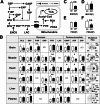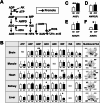Multi-omics analysis of diabetic cardiomyopathy pathogenesis using a type 2 diabetic Zucker diabetic fatty rat model
- PMID: 40595975
- PMCID: PMC12215485
- DOI: 10.1038/s41598-025-04670-5
Multi-omics analysis of diabetic cardiomyopathy pathogenesis using a type 2 diabetic Zucker diabetic fatty rat model
Abstract
Diabetic cardiomyopathy (DCM) is a leading cause of mortality in patients with diabetes, highlighting the need to better understand its mechanisms for effective treatment. The primary pathogenic mechanism of DCM is mitochondrial dysfunction associated with increased oxidative stress; however, the exact reasons why diabetes triggers this condition remain unclear. An 8-week-old male Zucker diabetic fatty rat model of type 2 diabetes was used for this analysis. Metabolomic and lipidomic analyses were conducted not only in the heart but also across several other organs to elucidate metabolic changes specifically occurring in the heart. Proteomic analysis and gene expression profiling using qPCR were performed on the heart to achieve a comprehensive understanding. The marked reduction of the radical scavenger carnosine and the increased gene expression of catalase and Sestrin2 in the heart suggested elevated oxidative stress. A decrease in Complex I proteins and an increase in Complex I gene expression indicate rapid mitochondrial turnover in diabetic cardiomyocytes. Additionally, the increased expression of adenylate kinase and xanthine oxidoreductase accelerated the adenosine monophosphate degradation pathway, leading to reactive oxygen species generation. These insights into mitochondrial dysfunction and metabolic disturbances could inform the development of innovative therapies and pharmacological approaches for managing diabetic heart failure.
Keywords: Diabetic cardiomyopathy; Metabolomics; Mitochondrial disfunction; Oxidative stress; Proteomics; ROS.
© 2025. The Author(s).
Conflict of interest statement
Declarations. Competing interest: The authors declare no competing interests.
Figures






Similar articles
-
Human umbilical cord-derived mesenchymal stromal cells improve myocardial fibrosis and restore miRNA-133a expression in diabetic cardiomyopathy.Stem Cell Res Ther. 2024 Apr 24;15(1):120. doi: 10.1186/s13287-024-03715-2. Stem Cell Res Ther. 2024. PMID: 38659015 Free PMC article.
-
Overexpression of PBX1 attenuates oxidative stress and apoptosis in diabetic cardiomyopathy by transcriptionally inhibiting TXNIP.Int J Biochem Cell Biol. 2025 Sep;186:106828. doi: 10.1016/j.biocel.2025.106828. Epub 2025 Jul 3. Int J Biochem Cell Biol. 2025. PMID: 40614857
-
Integrated multi-omics analysis reveals the functional signature of microbes and metabolomics in pre-diabetes individuals.Microbiol Spectr. 2025 Jul;13(7):e0145924. doi: 10.1128/spectrum.01459-24. Epub 2025 Jun 9. Microbiol Spectr. 2025. PMID: 40488467 Free PMC article.
-
Altered dietary salt intake for preventing diabetic kidney disease and its progression.Cochrane Database Syst Rev. 2023 Jan 16;1(1):CD006763. doi: 10.1002/14651858.CD006763.pub3. Cochrane Database Syst Rev. 2023. PMID: 36645291 Free PMC article.
-
Potential Significance of Targeting Ferroptosis for Intervention of Diabetic Cardiomyopathy.J Diabetes. 2025 Jun;17(6):e70116. doi: 10.1111/1753-0407.70116. J Diabetes. 2025. PMID: 40536196 Free PMC article. Review.
References
-
- Montaigne, D. et al. Myocardial contractile dysfunction is associated with impaired mitochondrial function and dynamics in type 2 diabetic but not in obese patients. Circulation130, 554–564. 10.1161/circulationaha.113.008476 (2014). - PubMed
MeSH terms
Substances
LinkOut - more resources
Full Text Sources
Medical

